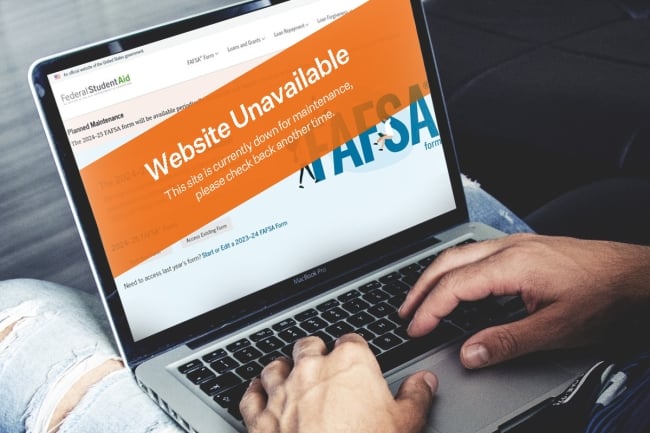You have /5 articles left.
Sign up for a free account or log in.

Those who logged on to fill out the new Free Application for Federal Student Aid in the first few days of its soft launch often couldn’t access the application due to pauses for site maintenance.
Photo illustration by Justin Morrison/Inside Higher Ed | Rawpixel | U.S. Department of Education
The Education Department rang in the new year by finally releasing a long-awaited new version of its application for federal student aid—sort of.
The form, which officially opened Dec. 30, has only been available for extremely limited windows of time. Periodic “maintenance pauses” locked students out for all but a few hours each day, and those who did manage to gain access to the form reported that they weren’t able to complete the application before being shut out. Others languished in a digital waiting room, on hold while the site processed the limited volume of users it could actually handle.
The Education Department’s rollout of the new Free Application for Federal Student Aid has been plagued by delays and uncertainty since the end-of-year launch date was announced. In the month leading up to the anxiously awaited deadline, more technical and scheduling concerns beset the department: a calculation oversight put the current guidelines out of step with the new form’s requirements, and lawmakers called on the department to offer more clarity and support for frustrated families.
So far, more than 400,000 people have started or completed applications, according to Education Department data. More than 150,000 applications were submitted by the end of Tuesday. Over all, more than 17 million students are expected to complete the application this year, which is required to unlock billions in federal, state and institutional aid.
The weekend’s starting-line stumble has exacerbated fears of a chaotic and frustrating spring for students, financial aid professionals and college access groups.
“It’s pretty bad,” said Bryce McKibben, senior director of policy and advocacy at the Hope Center for College, Community and Justice at Temple University. “I can’t sugarcoat the fact that folks are going to be disappointed. But I’m trying to hold out hope that maybe it’ll just be a little while longer and we’ll be able to fix this and get this turned around.”
The department made sure to set expectations low. On Dec. 20, officials announced that the long-anticipated FAFSA release would actually be a “soft launch,” during which they would test the new form in a kind of beta mode, opening it up to small numbers of applicants as they worked to resolve technological and administrative issues. They also announced that colleges, state grant offices and scholarship groups that rely on the FAFSA to calculate student aid eligibility wouldn’t get applicants’ information—delivered via the Institutional Student Information Record (ISIR)—until late January.
That announcement drew the ire and consternation of everyone from counselors to financial aid officers, whose fears about the form’s reliability appear to have been confirmed in the first few days of the year.
“Even by soft-launch standards, this weekend’s rollout was challenging and students, families, and financial aid administrators who have been waiting for this release for months are understandably frustrated,” Justin Draeger, president of the National Association of Student Financial Aid Administrators, said in a statement Tuesday. “Until we know more details about when schools will begin receiving finalized applicant data, schools cannot provide realistic timelines about when students and families will receive financial aid offers.”
An Education Department spokesperson stood by the soft-launch timeline, saying students should take their time filling out the forms while officials “ensure optimal performance and resolve minor issues.” She also said the department was gradually increasing the form’s window of availability.
Failure to Launch
Mark Kantrowitz, a college financial aid expert and consultant, said that after struggling for two days to test the new form, he was finally able to submit it on the afternoon of Jan. 2. When he asked a department spokesperson about the issues, he was told the form had only been open for about an hour each day from Dec. 30 to Jan. 1. The department spokesperson said the form was available from 10:30 a.m. to 4:30 p.m. Tuesday and will be open for the majority of Wednesday, consistent with call center hours
Kantrowitz said the site was more than frustrating—it was practically unusable. Many students and families, speaking with their counselors or taking to social media and Reddit forums, said the same thing.
Yes yes yes no
byu/gobluetwo inFAFSA
The National College Attainment Network issued a statement reflecting that frustration, noting that the application has been “mostly unavailable to students and families” since its Dec. 30 launch.
“Small numbers of applicants have been able to submit their FAFSAs, but [the Education Department] has taken the application down for long and unpredictable stretches of time to correct problems experienced by early users,” it read. “In these early days of the new FAFSA, NCAN asks ED to provide clear guidance about the days and hours when the form will be reliably available.”
Jill Desjean, senior policy analyst at NASFAA, agreed that the rollout has been challenging. The site has been down “a good amount,” she said, and even families that are able to access the website have reported being unable to complete and submit the FAFSA.
She added that the soft launch will likely last weeks or even longer, potentially running right up to the end of the month, when the department promised it would send applicant data to colleges.
“I hope students don’t give up,” she said. “Keep checking studentaid.gov. Try at odd hours when volume is a little lower. I just worry about people getting frustrated and quitting. The whole idea behind this simplification effort was to make it easier, so people wouldn’t give up.”
Frank Ballmann, director of federal relations for the National Association of State Student Grant and Aid Programs, said that while he’s glad there’s now a FAFSA available, an orderly rollout would have been better than rushing the launch to meet a deadline. Federal law requires the FAFSA to be available by Jan. 1, so a further delay would’ve required congressional approval.
“They had to meet this deadline come hell or high water—and they did meet the deadline,” Ballmann said. “From what I’ve heard, I think they’re actually working to address the issues they’ve identified, so I think they’re making the best of a challenging situation.”
Kantrowitz disagreed, arguing that the department hadn’t actually met the Jan. 1 deadline in practice.
“As far as I’m concerned, this is a failed launch,” he said. “The form is not fully open, and parents and students see it that way, too.”
A ‘Chaotic Financial Aid Season’
The bungled kickoff is the latest sign that federal financial aid could be more complicated this year, despite the “simplification” of the form. Counselors said they hope colleges recognize the challenges and offer more flexibility on commitment deadlines to align with anticipated delays in the availability of financial aid information.
“I’ve been telling students and parents to submit the application as soon as they can,” Kantrowitz said. “This is going to be a chaotic financial aid season.”
The delays will hit lower-income and first-generation students hardest: they’ll be faced with a crunched timeline to make college choices, and it will be more difficult for counselors and organizations to help those students expediently. NCAN calculated that this year, the organizations have one-third less time to assist families who need it, a problem exacerbated by the new inputs and requirements in the application.
Ballmann noted that state aid programs have already pushed completion events to later this month, so the department’s decision to hold off on processing the applications and sending students’ information to colleges could be “a blessing in disguise.”
“A student who applies later in January is going to be at the same place as anyone who fills out the FAFSA today,” he said.
Jose Jimenez, director of access at the California-based scholarship support organization 10,000 Degrees, said that even though California extended its state aid deadline by a month, the organization is encouraging students to submit their forms “as fast as possible.” Even then, he said, it’s possible some students will reach their May commitment deadlines without the concrete financial aid packages they need to make an informed decision.
“Low-income students may have to decide which college to attend before knowing whether they can afford it,” he said.
For those who do complete the application, the delays and compressed timeline also will mean that students have less time to review aid eligibility from colleges and evaluate the resources they have to pay for their education. Without more time to figure it out, they could become discouraged and forgo college entirely, McKibben said.
“I’m really worried about those students who are either trying for the first time or renewing their aid,” he said. “We lose them because they are experiencing frustration and what they perceive as dysfunction from this process and get alienated, essentially, from higher ed.”
‘Sadly Inevitable Result’
The new form is one piece of a broader overhaul of the federal student aid system and changes to the underlying methodology that determines aid eligibility. The revamp should open up the Pell Grant to more students and make the process easier for them and their families.
“It really is massive—that’s why it hasn’t been done in 50 years,” said McKibben, who helped write the 2020 law that mandates changes to the system while working with Washington senator Patty Murray, the top Democrat on the Senate education committee.
Known as the FAFSA Simplification Act, the law swapped out the Expected Family Contribution for a Student Aid Index to determine how much money a student should get, changed eligibility criteria for Pell Grants and ended the current discount for families with more than one child in college, among other changes.
Yet the Office of Federal Student Aid, which oversees the department’s student aid programs, did not receive additional funding this year to assist with implementing the law.
“It’s a sadly inevitable result of the agency being starved for funding,” McKibben said.
He said the department likely encountered technical challenges that officials didn’t expect as they updated the technology, adding that some errors are difficult to foresee until the application is rolled out to the general public.
“I don’t know if this was preventable or not,” he said. “I hope the answer was that it wasn’t.”
The current effort to simplify the FAFSA crossed two presidential administrations, which McKibben said further complicated the timelines.
“[The Biden administration] inherited a mess, so that’s why I try to give them some credit,” he said.
But Kantrowitz, who played a central role in launching the first-ever online FAFSA form in 1997, said he thinks something must have gone haywire at the department to make a last-minute scramble like the soft launch necessary after three years of advance notice. He was able to get a form up and running in nine months, he said, and that was when dial-up was still the primary mode of internet access.
“When you’re doing something this major and have approval from Congress years in advance, and you’re still not ready when the time comes, something must have gone very wrong,” he said.





